
Backlinks are a critical factor in search engine optimization (SEO).
They act as votes of confidence, indicating to search engines how authoritative websites are and helping sites like Google choose what to rank first.
If you’re not familiar with backlinks but want to learn more, you’re in the right place.
Think of this as backlinks 101—we’re going to explain the basics, including:
✅ Why backlinks are important to SEO.
✅ How to build them.
✅ The easiest way to boost your backlink profile.
But to understand how backlinks fit into SEO, you first need to understand what a backlink is.
What Are Backlinks?
A backlink is a hyperlink from one website to another. They are usually highlighted in a different color and underlined.
Writers include backlinks in their content for one of several reasons, including:
🔗 To attribute ideas or work that aren’t their own to the originator.
🔗 To provide readers with additional information.
🔗 To guide readers to the next stage of a user journey.
Here’s an example from one of our other articles:
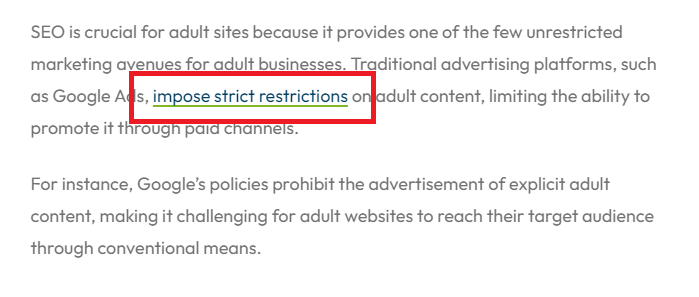
This relates to the second point. Users can click this link to learn more about Google’s advertising restrictions.
Backlinks aren’t just important for the user experience—they also play a crucial role in search engine optimization (SEO).
Let’s explore that in greater detail.
Why Backlinks Are Important for SEO
As you can tell from the section above, most people link to sources because it is useful or credible.
Search engines understand this and use backlinks to measure how authoritative a website is. Websites with high authority are more likely to be ranked higher for relevant search terms.
Search engines also consider the number of referring domains, the quality of backlinks, and how varied a backlink profile is.
Let’s investigate these considerations in more detail.
Number of referring domains
This is how many different websites link to your content.
10 links from 10 different websites are usually worth more than 10 links from a single website. This is because the former represents a wide range of sources vouching for your content.
Quality of backlinks
Some backlinks are worth more than others. The factors that affect this, include:
✅ Relevancy
Backlinks from websites and pages that are relevant to your content are worth more than those from less relevant sources—even if the linking website is highly authoritative.
This is because search engines know that guiding audiences to topically relevant content is critical to a good user experience.
✅ Authoritative
Backlinks from authoritative websites are worth more than backlinks from less authoritative websites.
✅ Natural
Backlinks that were placed because the webmaster thought their audience would find the content useful are more valuable than those that were purchased purely to rank higher.
✅ In-content
Links should appear in the body copy of articles. Backlinks placed in footers and other places are often associated with spammy link-building techniques and are less valuable.
✅ Good traffic
High traffic shows that a website is active and useful to users. Links from these websites are usually of higher quality. Plus, they are a good source of organic traffic and expose you to new audiences.
✅ Relevant anchor text
Anchor text is the highlighted words you read and click on in a backlink. These words should be relevant to:
✔️ The context they appear in.
✔️ The content they lead to.
The anchor text in the example below is relevant to the context and the content it leads to because we’re writing about SEO tools and the anchor text links to SEO tools.

Variety
Imagine your website has very few backlinks pointing to it. Suddenly, overnight, 20 guest posts appear with links to your site—all are about the same subject and all have the same anchor text.
Does this sound natural? Or the result of a contrived link-building campaign?
Having a range of backlink types from a wide range of sources and with varied anchor text indicates that the links pointing to your site are natural.
Therefore, websites with a varied backlink profile tend to rank higher.
Backlinks are crucial for SEO, but they come at a cost; if you plan to invest in link-building services, consult our link-building pricing guide to plan your budget.
What Makes a Bad Backlink?
Google policies dictate how it chooses which websites to show in search results.
It says that any attempts to manipulate search results are considered a violation of its spam policies.
Link practices that Google considers a violation include:
- Buying links
- Excessive link exchanges
- Building links using automation
- Link cloaking
- Low-quality directory or bookmark links
- Sitewide links
- Forum or comment spam
Google uses automated systems and human reviewers to detect policy violations.
If a website is found to have broken these policies, then it may be issued with a manual action.
This may lead to a website ranking lower in search results or not appearing in them at all. 😱
The truth about Google’s spam policies
Google’s rules are vague. For example, does paying an agency to build a link count as buying links?
In our experience, buying links, exchanging links, and building them in directories and forums can be a good way to acquire links, so long as:
✅ You do it on reputable, relevant websites.
✅ You offer value to readers.
✅ You use these techniques sparingly.
✅ You approach building them in the right way (more on this in the next section).
Even if you do build a few links in a way that violates Google’s spam policies, it’s more likely that Google will ignore your links rather than issue a penalty.
However, build excessive numbers of these links, then the chances are you WILL receive a manual action.
This tends to happen when you hire cheap, low-quality link builders who employ spammy techniques like comments spam or when you rely on link farms and public blog networks (PBNs) to build your links.
⚠️ Beware of link farms and PBNsBacklinks are a powerful ranking factor. Many people have worked this out and have set up websites that only exist to make money by publishing bad backlinks. These websites are known as link farms and PBNs. They usually have:
Publishing links with these websites might lead to a short-term boost in traffic, but they quickly become worthless once Google realizes what they are. |
How to get rid of bad backlinks
If you think you have been issued a rankings penalty due to bad backlinks, then you can take action to fix the problem.
Google’s disavow tool allows you to submit a request to the search engine highlighting the toxic links and asking it to ignore them.
Using the disavow tool shouldn’t be taken lightly. It’s impossible to know which links contribute to your rankings and disavowing the wrong ones can seriously mess up your traffic.
For more information, check out our guide to disavowing backlinks.
Here are a few extra caveats to using the disavow tool:
⚠️ Only use it if you’re sure
You should only use the disavow tool if you’re sure you were issued a rankings penalty due to bad backlinks. You can do this by visiting your Google Search Console, clicking the “Security & Manual Actions” drop-down arrow, and choosing “Manual actions.”

⚠️ Google may ignore your request
Google is under no obligation to honor your request to disavow backlinks. In fact, most website owners will have to send a disavow request at least twice.
This is because Google often has good reason to believe that you have been engaging in poor link-building practices and no longer trusts your website; therefore, it doesn’t want to let you off the hook that easily.
How to Get Backlinks
There are many different ways to get backlinks. However, some techniques are commonly used by link builders because they’ve been proven to deliver results.
This section lists some of them.
Publish linkable assets
This is when you create high-quality content, publicize it, and then let it naturally draw links. Notice we say “assets”—that’s because we’re not just talking about written content.
Linkable assets cover:
💡 Infographics
💡 Videos
💡 Free tools or apps
💡 Webinars
💡 Images
💡 Research reports
The good thing about this link-building technique is that your assets just sit there attracting backlinks.
These backlinks are high-quality because people place them only if they like your asset and think their audience will, too.
This is exactly how Google and other search engines want you to build links. But there are some downsides to linkable asset campaigns.
Namely:
⚠️ It’s expensive: Creating high-quality assets requires expertise and time. This means producing them can be expensive.
⚠️ It takes time: It can take time for an asset’s popularity to snowball.
⚠️ Results can vary: You might put lots of effort into producing a research report, only for a more well-known competitor to launch one of their own. This means that you’ll get fewer backlinks.
Example: Deloitte Gen Z and Millennial Survey
Here’s an example of a research report from audit, assurance, consulting, and tax services provider Deloitte.

They published a survey on the views of Gen Z and Millennials regarding:
🔍 Climate action
🔍 Generative AI at work
🔍 The future of work
🔍 Mental health
The company works with many large businesses that will be interested in the views of these age groups from a recruitment and HR perspective.
But more importantly, this research will be useful for anyone writing about Gen Z, Millennials, or any related topic. Deloitte is a large, well-known company, so their research will be credible to readers.
That might be why the report has earned nearly 2,500 backlinks in just over six months.

These backlinks are from some massively authoritative websites, including:
- Forbes
- The Guardian
- Hubspot
- CNN
- Harvard
- BBC
Get featured on resource pages
Resource pages are curated roundups of high-quality assets that a website owner thinks their users might find useful.
Here’s an example of what resource pages look like. Gardeneers is an organization that helps schools in Chicago start and manage gardening programs.
It has a page full of resources for different stakeholders. These resources have been pulled from around 20 different websites, providing schools with a wealth of useful information.

The best way to find resource pages relevant to your business is with a Google search.
Try using the following search operators:
- Your keyword + “inurl:resources”
- Your keyword + “best resources”
- Your keyword + “useful resources”
- Your keyword + “intitle:links”
- Your keyword + “helpful links”
Research each page and check if there is room for your content—you don’t want to propose linking to your content when the resource page already covers it. You might have to create new content if you are struggling to find an opportunity.
Next, reach out to the website owner and propose that they add your content to their list.
Find unlinked brand mentions
This is when someone mentions your business online but does not link to your website. You can remedy this by simply reaching out to the person and suggesting that they add a link.
Here’s an example where we have been mentioned by affiliate marketing blogger Nikola Rosa.

This example provided us with a great opportunity—the blogger seems to be recommending us and we obviously didn’t ask him to do this (otherwise we would have asked for a backlink in the first place).
And unlinked mentions don’t just have to involve your company name. Other options include:
💡 The names of your CEO and any senior staff.
💡 The names of any products or sub-brands you own.
💡 Your company slogan.
But how can you find these opportunities en masse? We suggest using the SEO tool Ahrefs.
Once you’ve signed up for a paid account, head to the Content Explorer in the top menu.
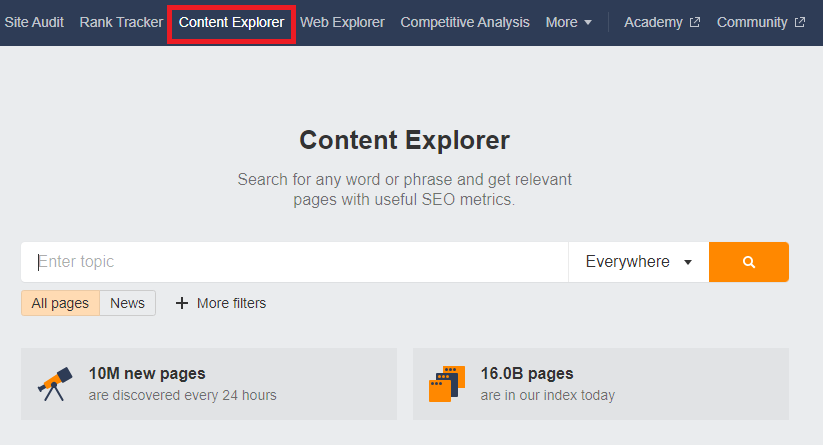
Type: “[Your brand name]” -site:[authority.builders]
So for us, this would be: “Authority Builders” -site:authority.builders
Click the orange magnifying glass and you’ll be shown the results.
Click the box titled “Highlight unlinked” and type your website address again.

The websites that mention you but do not link to you will now be highlighted.
Here’s another opportunity we’ve found that involved one of our founders. Matt Diggity was interviewed by business and startup media website Inc.
The page links to one of Matt’s other companies but not to ours. Inc. has a very high domain rating (DR) of 91 so this opportunity is well worth pursuing.
🤔 What is domain rating?Domain rating is a measurement of a website’s authority. It is measured on a scale of 1-100, with 100 being the highest authority. Websites with higher authority are more likely to rank for relevant keywords. This measurement was created by SEO tool developers Ahrefs. Its calculation is based on several factors, but the main one is the number of backlinks pointing to the website. Other SEO tools such as Moz, Semrush, and Majestic also have their own versions of DR. |
Fix broken links
Broken links are when a link no longer works because the page it points to, was either moved or removed. The user is usually directed to a 404 page.
This represents a good link-building opportunity. If you can spot broken links that used to point to your competitors’ sites, then you can contact the owners of the linking site and suggest they fix the link by pointing to your page instead.
Broken links impact the user experience and can lower your rankings; therefore, website owners will probably want to fix the problem.
Ahrefs provides a free broken link checker that quickly shows broken links on a website.
Let’s use it with the online guitar magazine Guitar.com.
One of the first articles that comes up is a roundup of upgrades you can make to a Fender Telecaster guitar. The article has three broken links.
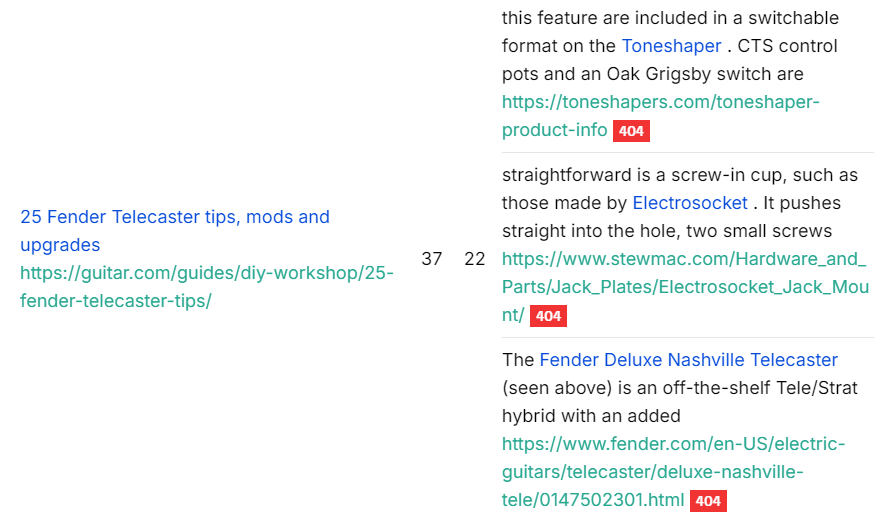
The middle one is for a product that was removed by the retailer. If you sell a similar product, then you could get in touch with Guitar.com and suggest they link to your product page instead.
Get quoted by journalists
Digital PR links are when you get your website featured in the media.
Media websites are usually trusted by search engines and are often very authoritative. This means that these backlinks are great for your SEO.
But it’s very difficult to get coverage from journalists.
There are two main approaches you can take:
- Launch a PR campaign: This is when you report something that your audience and relevant publications might find interesting with the aim of gaining coverage. For example, if you were a gardening website, you might host a family gardening festival in a local park where children could learn how to plant flowers and vegetables.
- Get quoted as a source: This is when a journalist chooses to quote you in a story they are writing. For example, they might be writing a piece on the mental health benefits of gardening and may need an expert to provide information.
The first option is hard to get right and you may need to hire a professional digital PR agency.
Getting quoted is easier to do yourself. You can contact the journalist, introduce yourself, tell them about your expertise, and even suggest an article you could help with.
However, journalists are inundated with this kind of outreach message and you may not get a response, let alone the opportunity to be quoted.
A better option might be to use a service like Connectively.
What is Connectively?
Formerly known as HARO, Connectively connects subject matter experts with bloggers and journalists.
Journalists post requests for expert quotes on a message board and experts send their responses. The journalist chooses a response to publish and usually includes a link to the expert’s website.
Here’s a good example of a query you could respond to if you worked in the gardening niche:
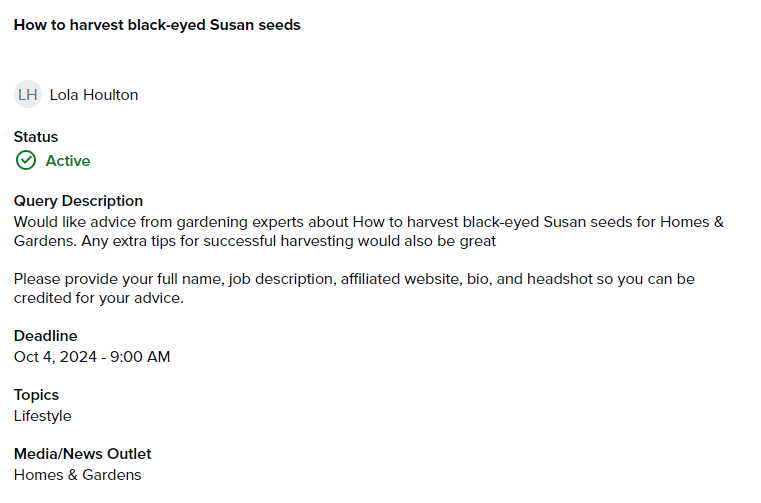
When responding to Connectively requests, remember to:
✅ Introduce yourself and highlight your area of expertise.
✅ Be short and to the point.
✅ Answer the question (don’t talk around it).
✅ Answer promptly.
✅ Offer to provide more information should they need it.
Publish guest posts
Guest posting is a very popular link-building technique. It involves writing an article for someone else’s website. In return, you get a backlink.
Guest posting is an effective link-building technique because you’ll gain:
✍️ Control: You get to choose which websites link to you and the keywords that your article is associated with.
✍️ Exposure: Your brand and expertise are exposed to new audiences.
✍️ Topical authority: When you regularly write guest posts, you’ll become more associated with related topics—and this could drive traffic to your website.
The easiest way to find guest posting opportunities is with a Google search.
1.Type: [relevant keyword] + “write for us”.
2. You could also swap “write for us” for other terms like:
a. Guest author
b. Guest blog
c. Become a contributor
3. Typing “gardening write for us” revealed several opportunities:

4. Create a spreadsheet that lists all the guest posting opportunities you found.
5. Once you have enough options, you’d need to find out which ones represent a genuinely good opportunity.
6. To do this, head over to Ahrefs and type each site’s URL into the Site Explorer tool.
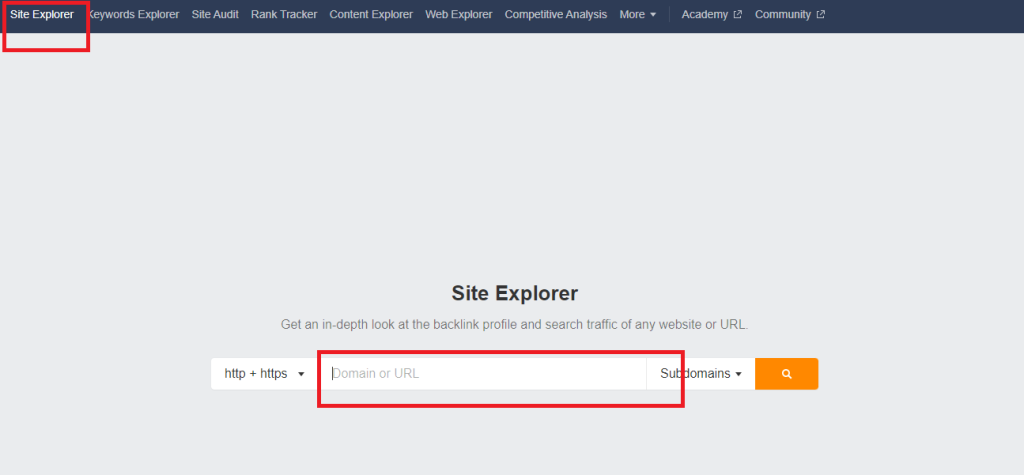
7.Look for a website with:
✅ DR higher than yours.
✅ Decent traffic, around 20,000 monthly visitors.
✅ No sudden drops in DR or traffic.
8.Add these metrics to your spreadsheet.
9.Now check out each of the website’s content. Look for:
✅ High-quality content.
✅ A mixture of guest authors and “home grown” content.
✅ Guest posting guidelines (this shows they care about quality).
✅ A narrow range of topics covered.
To demonstrate this, we looked at the top result in our Google search, Ground to Ground. The site has a low DR of 28 and low traffic of 1,300 monthly visitors.

However, traffic has grown steadily in recent years.

Upon visiting the site, we can see that it’s about using coffee grounds in gardening (and some poetry). This could be relevant—although it’s a very narrow topic!
The website has some limited guidelines, the content itself is well-written and was clearly contributed by enthusiasts, but most articles are very short.
Overall, this website might present a good guest posting opportunity if your website is brand new, but this opportunity probably wouldn’t suit most more established brands.
10. If you think any of the guest posting sites in your list are unsuitable, then remove them.
11. Now, order your spreadsheet by DR and traffic, and prioritize the best opportunities.
12.Reach out to each website and pitch an idea for an article. You may have to send a follow-up message as website owners are usually busy people.
Help people on forums
Forum link building has a bad reputation, mainly because unscrupulous link builders have spammed forums with links in the past.
But if you do it sparingly and provide value to forum users, then it can be a great way to build links and increase brand awareness.
Here are some tips:
- Only post on relevant forums.
- Build trust by getting involved in forum communities before you post your first link.
- Always follow forum guidelines—otherwise, you’ll quickly be banned.
- If allowed, include a link in your forum signature.
- Keep backlinks minimal and relevant to the discussion. Only post them if they genuinely add value to the discussion.
Here’s a good example from Ycombinator. A parent asked about keeping kids busy during the COVID-19 lockdown. An educational app developer offered a helpful suggestion with a link to an article they wrote on their website.

The app developer posted on more than 30 discussion boards on the forum and received lots of good feedback from users. Therefore, people would be more inclined to trust them when they post a link.
The Easiest Way to Build Backlinks
Backlinks are a vital component of any successful SEO strategy. They serve as endorsements from other sites, boosting your authority and helping you rank higher in search engine results.
But consistently building high-quality backlinks can be difficult. The quickest and easiest way to build backlinks at scale is to use a link-building agency like Authority Builders.
We’ve been building links for businesses like yours since 2016. Our in-house team audits your backlink profile and recommends the best strategies to drive traffic to your website.
Our team of professional link builders and content creators then launches high-quality campaigns on your behalf, ensuring you secure relevant, high authority, and long-lasting links.All you have to do is sit back and watch your rankings increase! Book a call today and find out how we can help you boost organic traffic.
